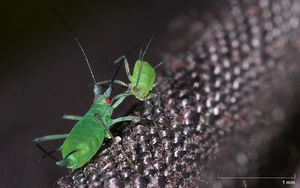More and more varieties of lilies are being developed that are hardier and more disease-resistant. This does not, however, mean that these same lilies will not from time to time be plagued by pests. Following are some of the common insects that attack lilies along with some recommendations for keeping these pests under control.
Aphids
These evil little pests can do a lot of damage to your lilies. They swarm onto the plants and begin to suck out the sap leaving behind a sticky substance called honeydew. Aphids can weaken your lilies and cause twisted leaves and malformed buds. They can also carry viruses to healthy plants.
For the occasional infestation, you can simply spray your lilies with the water hose. (Use the jet spray to better knock off the aphids. Also, be sure to spray the underneath sides of the leaves.) A particularly effective method for controlling aphids is to plant nasturtiums. I plant nasturtiums first thing in the spring throughout my gardens and, as a result, my perennials are seldom bothered by aphids. Other gardeners use a tea made of rhubarb. To make the tea, simmer one pound of rhubarb leaves in two and a half pints water for thirty minutes. Strain and store the extract in a glass jar. When you are ready to use, mix an ounce of dishwashing liquid in two and half pints of water and then add the rhubarb extract.
Slugs
Slugs generally do their damage in the early spring when new growth begins to emerge. If the slugs are not controlled, your lilies may not bloom that year. You can set some traps such as setting out a jar lid filled with beer to lure in the slugs and then drown them. If slugs are a major problem, consider planting some type of artemisia, which is an excellent slug repellent. [See my article on Companion Planting.]
Red lily beetle
This pest was first noticed in Europe. Over recent years, it has begun to appear in the eastern portion of Canada and the United States. The beetles themselves are a bright red and rather tiny. It is the larvae that do the damage. These larvae look like tiny slugs and have the disgusting habit of piling their waste on their backs. They can quickly devour the foliage on your lilies.
Gardeners who have had to deal with these pests have had success by using Neem products. You can also discourage them by cleaning up all debris in the fall, thereby not giving them a winter home. The North American Lily Society is also investigating the possibility of introducing natural predators into areas affected by these beetles.
Lily thrips
These little pests live in the bulbs and can cause the bulbs to grow weak and eventually die. You can kill the thrips by soaking the bulbs in very, very hot water for about an hour.
These are some of the most common pests that can attack your lilies. You can save yourself a lot of trouble — and damaged lilies — by planting them properly and giving them the care that lilies generally need. For instance, I have little if any trouble with pests when it comes to my lilies. [You might be interested in my articles on the Asiatic Lily and on the Oriental Lily.
References:
McGeorge, Pamela. Lilies. Auckland, New Zealand, 2004.
